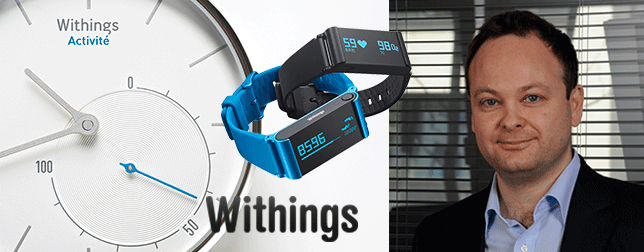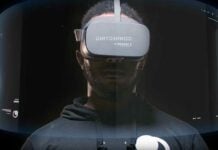Cédric Hutchings, co-founder and CEO of Withings, is one of the pioneers in connected devices, including wearable tech and other quantified self products. We had the chance to meet Cédric in Munich for an interview to discuss Withings’ development over the last few years and to talk about Cédric’s vision for his company and the connected devices industry.
Wearable Technologies: Hi Cédric. Just a few weeks ago, you announced a premium activity tracker which is integrated into a Swiss watch focussing on design and battery life. What is your strategy behind such a premium product?
Cédric Hutchings: Our goal is to make products that are useful in the long term. This works great with products such as body scales and blood pressure monitors, which people use anyways, but for wearables the situation is much more complex. Most of the people will not wear bulky plastic devices in the long term and of course they don’t want another device they need to charge every couple of days. That’s why we’ve developed the Activé, a beautiful Swiss-made watch which integrates sleep and activity-tracking. With a form factor a lot of people are familiar with and a battery life of one year, this activity tracker disappears and fully integrates into a product people would use anyways. When it comes to wearables, this is the only way to achieve long-time user engagement.
Wearable Technologies: Your company is one of the pioneers in the so-called internet of things. You offer connected devices for weight and activity tracking, blood pressure and sleep monitoring and two products to monitor the health and well-being of babies. Why did you pick the body scale as the first connected product and how do you decide which new solutions to add to your portfolio?
Cédric Hutchings: Our first product, the WiFi body scale, came to the market in 2009. My co-founder and I, we both have a background in the telecommunications industry and back then we both wanted to start a new venture in the connected devices industry. We were thinking about what kinds of devices really benefit from being connected and the body scale was one of the best ideas on our list. Since it’s a stationary device, we could work with WiFi, which allowed for a much more frictionless connection than we could have achieved with Bluetooth back then. With Bluetooth 4.0, which is common today, this is not the case any longer, but in 2008 it was much easier for us to develop a great product that connects through WiFi. When we think about new products, we always prioritize usability, so we question: Can we really make a difference in adding a connection to the existing product? Can we make the product simpler? For us it is not about connecting products, it’s about making products more useful. The body scale is such an example where it’s much more useful if it not only measures data, but also records it. One day, we will look back at scales which are not connected and think that they are really dumb and not very useful.
Wearable Technologies: One of your upcoming products, the smart sleep system Aura, is designed to monitor sleep, but also to improve sleep quality by stimulating its user with light and sound. Do you see a trend in self-tracking products towards not only capturing data but also using triggers such as smart environments to make an impact on the user’s quality of life?
For consumer products, numbers are nothing if they don’t have an impact. In the example of the activity tracker, data works fine and many users are motivated towards being more active just by being conscious about it. For sleep, on the other hand, the mechanics are different. People don’t really sleep more just because they know about their lack of sleep and – what is even more important – people just don’t have the skills at hand to improve their sleep quality. In order to really make a change in sleeping habits and sleep quality we need to make the data actionable by using triggers which influence the user much more subtly than just looking at numbers. By working with light and sound, we can actually influence the user on a physical level, making it much easier for him to improve his sleep. This works great with sleep, but in other cases we are looking at other triggers. We are always asking ourselves, what’s the best way to coach people and motivate them?
Wearable Technologies: With the heart-rate monitoring capabilities embedded in your blood pressure monitor, WiFi body scale and activity tracker, your customers can easily capture heart-rate readings in addition to their weight, activity levels and other metrics. The smart sleep system will even be able to record heart-rate data continuously every night. What’s the potential for this large number of heart-rate readings?
Cédric Hutchings: Our goal has always been to allow users to assess health data without being in the way. That’s why we call our scale a body analyzer and we are looking to integrate even more sensors into this device in the future. With the smart sleep system we have the ability to assess respiration and heart-rate data for many hours every night. This is just the beginning, but I believe these lifestyle devices could one day become a serious diagnosis tools. Any way, it’s a long way to go until we get there. Something that we plan to add in the near future is a possibility for the user to add context. Only if we can correlate data with certain lifestyle factors or other influences that we are not measuring with our products can we really get a deeper understanding and hopefully help beyond prevention.
Wearable Technologies: While most of your products relate to wellness and lifestyle, your blood pressure monitor is a medical device and has been approved by the FDA. How big an effort was it to develop a medical product and what potential do you see in the medical field?
Cédric Hutchings: Getting products approved by the FDA is challenging for startups and needs a lot of extra resources. For us, the blood pressure monitor was a clear priority on our roadmap, since it’s one of those products which gain a lot of value once they are connected. Patients are talking about their self-recorded data with their doctors in order to improve their treatment and with a connected blood pressure monitor, we could make this process so much simpler. In the future, lifestyle products should also integrate with health applications. Only if lifestyle applications relate to health are they relevant in the long term. Many of the self-tracking solutions available today are already really powerful. It takes time to build the evidence and further explore the opportunities in the medical field and we are just getting started.
Wearable Technologies: Thanks for the interview!
Withings will be part of our Wearable Technologies Show at the world health forum MEDICA. The WT I Wearable Technologies Show 2014 I MEDICA this November in Dusseldorf will be a great opportunity to learn more about Withing’s products and other solutions in the medical field.













